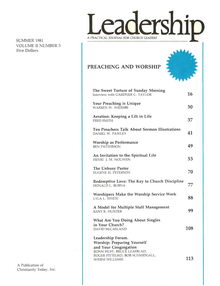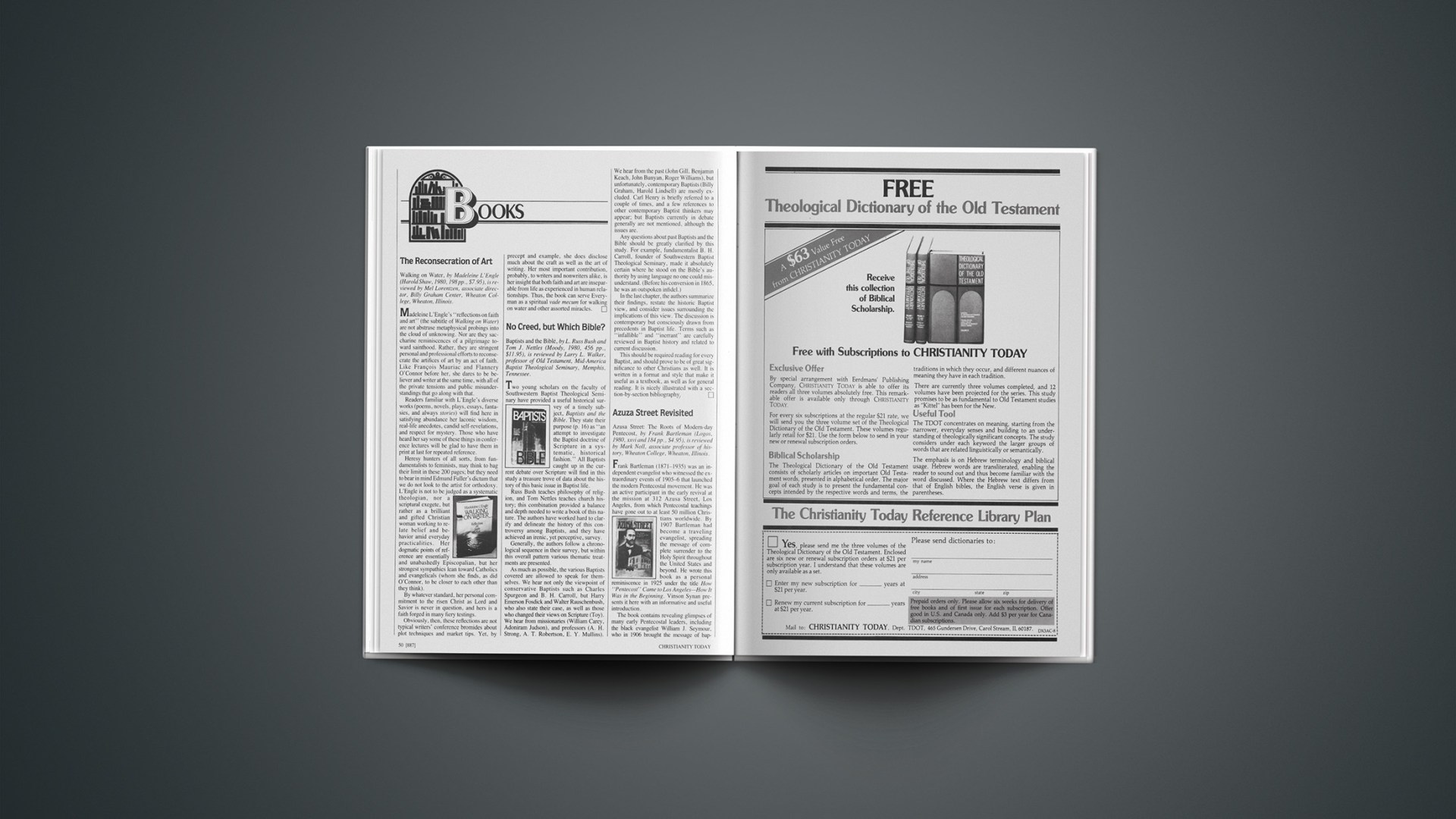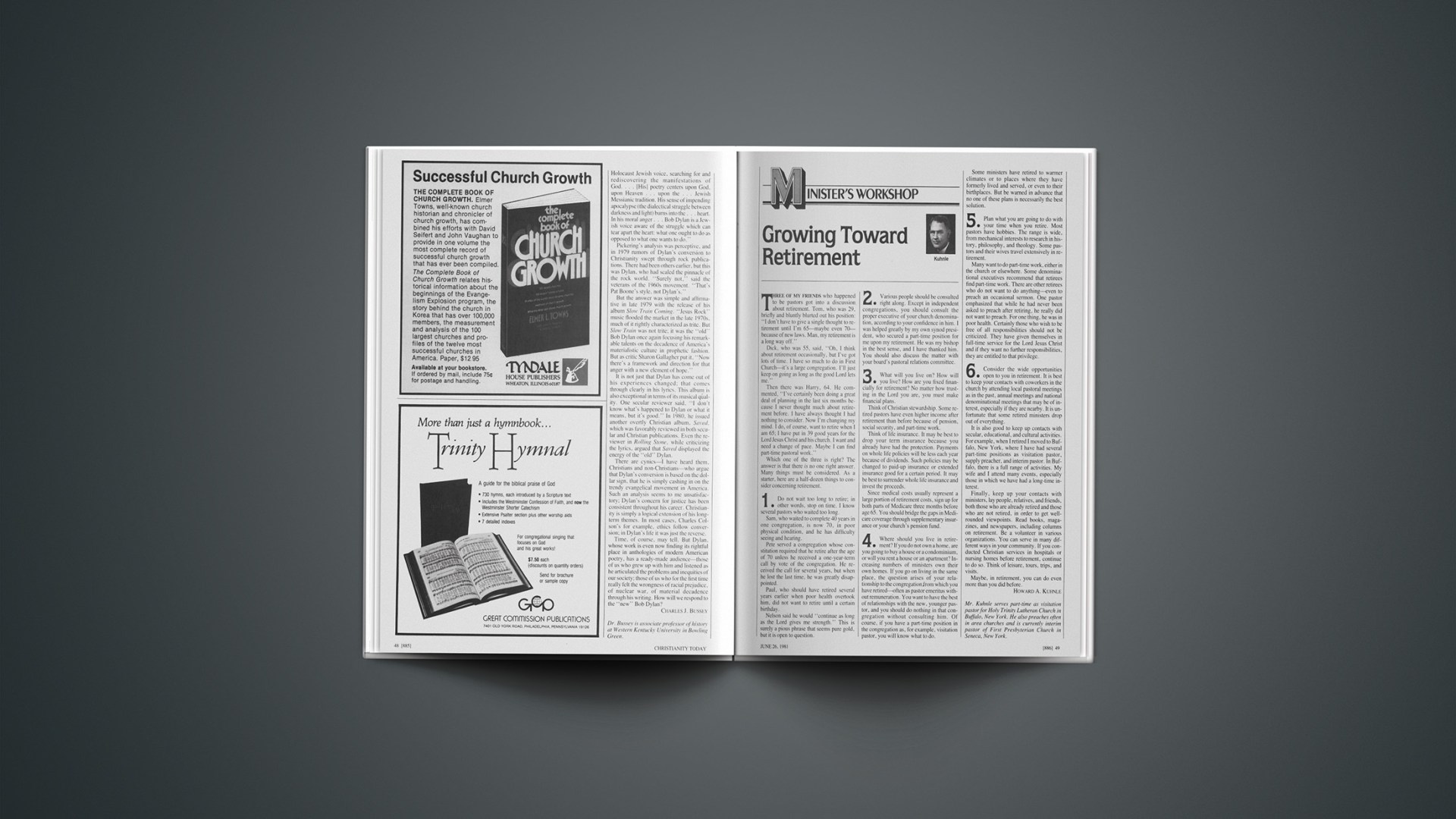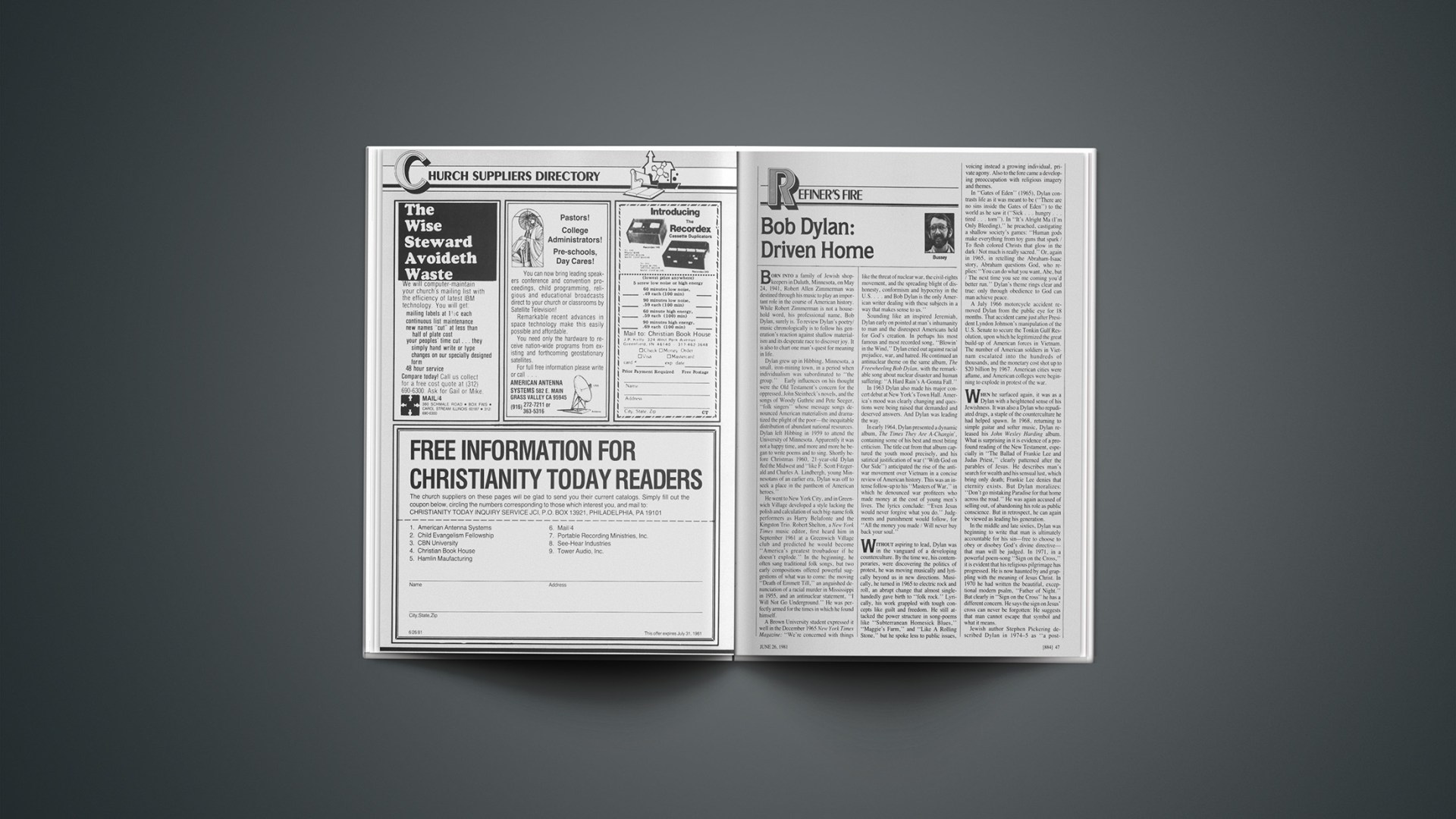In this series: Improving Your Illustrations
If someone who heard you preach last Sunday remembers anything at all that you said, chances are it was one of your illustrations. But illustrating wisely and well doesn't happen automatically. People get tired of hearing the same stories from your life, over and over, year after year. Pulling illustrations from the headlines keeps things fresh but can feel forced if your main goal is to make a biblical point feel relevant.
Preachers know how difficult it is to find illustrations that help explain and apply a biblical text. The articles below will help you think about why they matter, what makes them work, and how to make them stick.
One of the most difficult tasks of sermon preparation is finding appropriate illustrations. LEADERSHIP decided to ask several notable preachers how they have done it. Assistant editor Dan Pawley talked with fames Boice, Herschel Hobbs, Oswald Hoffmann, David Hubbard, Calvin Miller, Norman Vincent Peale, Paul Rees, Haddon Robinson, Paul Smith, and Charles Swindoll. Each suggested places to look for illustrations and gave examples of illustrations they’ve used in their sermons.
When Immanuel Kant sent a draft of his 750-page Critique of Pure Reason to a colleague for comments, the man read part or it and told Kant, “I’ll go mad if I try to finish reading this. You have included no illustrations.” Kant was sixty years old, and he feared he’d never finish the manuscript if he stopped to illustrate his points. Thus, he produced a cumbersome work, too windowless for even his philosopher friend.
“Windowless,” is the term Clarence E. MacCart-ney used in describing some ministers’ sermons. “In eastern Russia,” he noted, “one can see strange-looking houses. They are built like towers, solid, substantial, lofty, but without a window.” Sermons need windows so light can stream in and illumine the abstract interior. Haddon W. Robinson, president of Denver Conservative Baptist Seminary, says, “Good pulpit communication moves back and forth from the abstract to the concrete. Each time the preacher states a deep, broad, general truth, the mind of the audience asks. Tor instance?’ That’s when you need an ‘abstraction lighter,’ a concrete example which applies the truth.” Concrete examples, however, are not always easy to find. David A. Hubbard, president of Fuller Theological Seminary, admits, “I have to confess that illustrations are hard for me when I’m thinking conceptually about theology. Often I will construct a tight sermon outline only to struggle with how to open a window that lets light and air into my sermon so it doesn’t sound too cerebral, too prepositional, too closely reasoned.”
Do sermon illustration books help? Most of the interviewed preachers reject this source for illustrations. Paul S. Rees, editor at large for World Vision International, claims, “Early in my ministry I wasted a lot of time with illustration books. I feel they were bland and not relevant to my life.” Hers-chel H. Hobbs, former president of the Southern Baptist Convention adds, “It’s not only that prepackaged illustrations are usually dead and out of date, but psychologically they lose their sense of immediacy. I have a hard time getting excited about sharing someone else’s illustration in my sermon.”
Even when you discover a good illustration in your own experience that is appropriate to your subject, there’s always the danger of overemphasizing it. Sermon illustrations should always serve the sermon, and it is a mistake to build a sermon around an attractive story. Haddon Robinson comments, “Every preacher knows the value of a good story: it gets attention, it’s concrete, people listen. But right there lies the danger. The tendency is to tell the story for its own sake and not for what it illustrates. An illustration is like a row of footlights that shed light on what is presented on the stage. If you turn the lights into the audience, they blind the people.”
Norman Vincent Peale, pastor of Marble Collegiate Church in New York City, once complained to baseball manager Branch Rickey, “Sometimes I feel I’m just not getting my message across to my people.” Rickey told him to be concerned, but not to “over push.” “Sometimes baseball players over push,” Rickey said, “and they mess up their easy flow. You have to be loose as ashes.” To Peale, the message was clear: don’t overload your sermon with gimmicks; let the message flow and make the stories supplementary.
If prepackaged illustrations are out, then where should preachers go for what they need?
Observe the Ordinary
“Sometimes nowhere,” says Oswald C. J. Hoff-mann, speaker for The Lutheran Hour radio broadcast. “The preacher needs to be a constant observer of ordinary things that happen around him.
“One night my wife and I were sitting outside, and our dog Mack stood barking at us. Suddenly my wife said, ‘The children must have been playing with Mack because he’s off his chain.’ But the do^ didn’t know it, and he would go only to the spo where the chain usually yanked him back. W( watched to see how long it would take him to realiz< he was free. After about ten minutes, he discoverec he was not held by the chain, and he boundec happily to us.
“It occurred to me right then that this was a pic ture of how people live: we live shackled by ou passions and prejudices and pride. The Lord died t’ set us free, but as long as we think we’re bound b chains, then we really are. When we realize freedor is ours by faith in Christ—the shackles have bee broken—then we are free indeed. The story brin^ to life a major point on which the whole sermon built: freedom in Christ.”
Be Sensitive to Nature
The Welsh preachers of the eighteenth and nin teenth centuries considered nature a good sour for illustrations. Something as simple as a stream water trickling from a stagnant pool suggested Welsh preachers the fact of original sin: humani contaminated at its very source through the fall Adam. The simple beauty of a sunrise suggests t person of the Holy Spirit to Paul Rees. “Beyond t shimmering line of white foam, a sheen of bi nished gold stretches until the blue sky dips touch the ocean. All the while the sun seems to saying, ‘Don’t look at me, look at the glories 1 revealing to you.’ So it is with the Holy Spirit as reveals and magnifies our Lord.”
Being sensitive to nature helps the preacher co his sermons with the sights and sensations of r life. Recently, as Norman Vincent Peale preacl-the funeral service of magazine publisher DeV Wallace, he carefully integrated an illustration fr nature into his sermon. “It is the end of March c the beginning of April, and this wind that we feel signifies the rebirth of the earth. I know what beautiful flowers are here in summer, even though the ground looks barren now. But there’s life underneath these barren twigs and leaves and grass. The sun will overcome the wind and cold and soon it will be spring. This is precisely what DeWitt Wallace believed about life. He was a Christian; he believed in the Bible; he accepted Jesus as his Lord and his Saviour. I want to tell you we are in the presence of immortality here.”
You don’t even have to experience nature firsthand to derive its benefits. David Hubbard immerses himself in the National Geographic. “Perhaps I’ll see an article about the Amazon River and use it to illustrate the river glorious, which is the peace and love of God.”
Read Widely
Reading is an invaluable source for illustrations. The list of books and publications mentioned is diverse. “But,” you might ask, “isn’t reading just another way of gathering prepackaged illustrations?” Paul Rees reminds us that “You don’t read just to cull stories. You read for enrichment, keeping an eye open for illustrations, but selecting them only as they become relevant to your experience and sermon topics.”
An illustration is like a row of footlights that shed light on what is presented on the stage.”
Biographies often lend themselves to good sermon illustrations. According to Rees, “People are usually interested in the lives of great people. But you have to remember two things: 1) The biographical character has to relate in some meaningful way to the life experience of your audience; 2) There needs to be a close, recognizable relationship be- tween what you’re pulling out of a person’s life, and the point you’re trying to make.” He uses an illustration from the life of John Wesley when preaching on the passage from Philippians, “You shine as lights in the world.” “Once Wesley was preaching in the open air when a gang of roughnecks threatened to break up the meeting. The gang was armed with brickbats, and just as they were about to throw them, Wesley’s face lit up with a radiant smile. One of the gang members shouted, ‘He ain’t a man, he ain’t a man,’ and they were all stunned and quiet. As Wesley walked through the crowd that evening, his face was still radiant, and one of the gang men bers said, ‘He is a man—a man like Jesus Christ.’
James Montgomery Boice, pastor of Tenth Presbyterian Church in Philadelphia, also believes in tr biographical illustration because “most people ai interested in history that directly connects with the lives. When a preacher reads a biography of Luthe for instance, he is sitting on illustrations that app to the Christian life in total.” In a sermon abo prayer, Boice wanted to counter the statement, “If be thy will,” a line he says Christians use when v don’t really believe anything is going to happen. ” the heat of the Reformation, Luther received wo that his friend Fredrick Marconius was dying. L ther wrote back, ‘I forbid you to die. This is my wi may my will be done; the Lord will never let r hear that you are dead because of the work of t Reformation.’ Marconius was too weak to hear speak, but eventually he did recover and outliv Luther by several years.” The possibilities of drawing illustrations from literature are endless. Paul Rees reads poetry; the metaphor and imagery of John Masefield’s The Everlasting Mercy inspired an illustration of the transformation of a person’s character by faith in Christ. The humor of Mark Twain has found its way into the sermons of Calvin Miller, pastor of Westside Baptist Church, Omaha, Nebraska.«•
In his reading, David Hubbard will occasionally pick up on a single word or phrase, something contemporary and eye catching, and will make an illustration out of it. Not long ago he stumbled on the word “Balkanization”—the division of a country, a party, a faction against another. He had been planning a sermon on the disintegration of Christian discipleship, and after the sermon was prepared he inserted this illustration: “Back in the nineteenth century the Balkan Peninsula was exploited. Country was set against country and this became part of the overture for World War I. The same kind of Balkanization is happening in Christian discipleship today. Some powerful Christian leader tries to rally us around family life; another rallies us around Christian piety; another, social action. Our wholeness is being compromised and divided by the power politics of Christian leadership. We’re being Balkanized.”
Use Science
In a sermon designed to get people to examine their priorities in life, Chuck Swindoll, pastor of First Evangelical Free Church, Fullerton, California, tapped into data from a scientific experiment he read about in Smithsonian. “A researcher built a cage to house 160 mice. All their needs were met: plenty of food and water and the right climate. He let the population increase, much more than normal, and in less than three years the mice population reached 2,200. At that point the colony began to disinte- grate. The adults formed groups of about twelve each; each mouse played a particular role, but there was no role for the healthy young mice, so they began to disrupt the society. The males who had once protected their territory withdrew. The females became aggressive and forced out the young. The young mice became self-indulgent, eating and sleeping. Later, courtship or mating ceased, and in five years all the mice died, even though there was plenty of food and water, no disease, and an ideal climate.
“Now the scientist who did this research suggested that overcrowding humanity in such an inescapable environment might have similar effects:
‘First, we would cease to reproduce our ideas, then our goals; finally, our values and priorities would be lost.’ But the church has to minister in a different way. We experience the same things, face the same societal problems, but we think differently, and we can’t use the world’s methods. Our priorities and values must come directly from the Word.”
James Boice notes that Spurgeon studied science constantly, “and in the nineteenth century far less scientific knowledge existed.” A good way to govern the use of science, Boice suggests, is to stay aware of science that is newsy as well. He tuned into news reports of the geological Plate Tectonics Theory, the theory of the constant change and movement of the earth’s crust. In a sermon about the will of God, Boice pointed out, “In some places continental plates rub against each other with very little friction, and adjustment takes place gradually. But occasionally the plates lock in place, pressure builds, and a wrenching adjustment causes one plate to leap ahead—producing an earthquake. That’s exactly what happens in some Christians’ lives: we lock ourselves against the will of God, the pressure builds, and eventually the abrupt dealing of God comes. But if we yield little by little, we’re gradually molded into the image of Christ.”
Boice and Hubbard issued strong warnings: make sure your facts are correct when you’re talking about science. If Hubbard cannot verify the accuracy of a scientific illustration, he will scrap it. Boice sometimes contacts experts in his congregation. Last Easter, for instance, part of his sermon probed different theories on death. The afternoon before he preached, he verified his illustrations with one of his parishioners, a nurse with knowledge on the subject, and he wound up reworking much of his sermon.
Discover Humor and Imagination
“When you tell a good story,” says Chuck Swin-doll, “immediately there is interest because your audience is asking, ‘What’s going to happen now?’ Humor adds an interesting twist, but slapstick, joke book humor is not good. Good humor exists in real-life stories and predictable situations.”
There was unanimous assent in suggesting the use of humor. Norman Vincent Peale said, “If there’s humor in a story, let the humor come out, but don’t force it.” Some caution also was expressed to be careful of stepping over the fine line that keeps a humorous illustration from fitting the dignity of its sermon topic.
Illustrations drawn from the imagination also grab and hold attention, but it’s hard to draw good illustrations from the imagination week after week. David Hubbard offers this clue: “I keep my eyes open all the time for events, situations, statements that my imagination can caricature into a creative illustration.” Paul Smith, pastor of The People’s Church, Toronto, Canada, stumbled onto one image-evoking statement by Helmut Thielicke:
“… the fact that the salt is there doesn’t mean everyone is going to turn into a Christian, any more than when you put salt into a bowl of soup the soup turns into salt.” Smith used his imagination to inject life into it: “In my illustration I have a kitchen table, a salt shaker, and a bowl of soup. I call the salt shaker ‘the ecclesiastical salt shaker,’ and I describe it as the church, which is a good thing. The soup represents the world, and the salt’s objective is to get into the soup. I imagine two grains of salt having a conversation, and one is exuberant about enjoying the fellowship. ‘We’re both the same size, same color, we like each other, we’ve got these walls of glass around us and it’s all kind of neat.’ Then the other grain says, ‘Yeah, but at some point, I think we’re supposed to be dumped into the soup.’ “
The more the illustration represents your life experience, the greater will be its impact.
According to David Hubbard the preacher has to use some degree of “impressionistic portraiture,” but it should be done within reason. “You don’t want to go so far that you smother your sermon,” he says. Oswald Hoffmann adds, “It’s like an ice cream sundae; you have to use chocolate sauce with discrimination. If the whole sundae becomes chocolate sauce, then the sauce loses its effect.”
Be Authentic
One of the biggest dangers with sermon illustrations is that they sometimes come across stilted or contrived, and don’t ring true with the preacher’s personality and experiences. “Every preacher enters into a kind of covenant relationship with his audience,” Haddon Robinson states. “In the covenant are unspoken agreements about sermon length, depth of scholarship, and authenticity of illustrations. Violating that covenant in any way can mean losing your listeners.”
“Authenticity” is the word these preachers stress when discussing illustrations. The more the illustration represents your life experience, the greater will be its impact.
Norman Vincent Peale brings this into focus with a sermon illustration in testimonial form, which he integrates into a message about rededication to Jesus. “Once the bottom just seemed to fall out of my life and ministry, and I became very discouraged. My wife and I decided to go to England to get away from it all. I was not thinking very positively, and kept telling her how badly things were going, how little I amounted to, and why did I ever get into this situation anyway. I filled her poor ears with so much misery. Finally, she sat me down on a bench and said, ‘Norman, I don’t know what to make of you. You’re my husband, but you’re also my pastor. I sit in the congregation and listen to you talk about faith, the power of the Holy Spirit, and what Jesus Christ can do in a human life. Are those merely words for you or do you really mean it?’ ‘Of course I believe it,’ I said.
” ‘Well,’ she said, ‘you’re not acting like it. You hold it as kind of an intellectual belief, but haven’t you really been converted?’ ‘Of course I was converted,’ I said. ‘Well, it sure has worn off/ she said. ‘Now I’ll tell you what I’m going to do. I’m going to make you sit on this bench until you surrender your life, your church, your future, everything to Jesus Christ.’ Well, I did just as she said, and suddenly I began to feel warm all over. I jumped to my feet and said, ‘Wow, something has really happened to me. I feel excited!’ Then I wept out loud and said to my wife, ‘Tell you what. Let’s quit fooling around here. I want to get home and go to work.’ “
Illustrations authentically drawn from experience touch lives. “People relate most completely to what others have gone through,” Peale says. “When they see their own experiences of frustrations, sufferings, and joys against the background of the gospel, they are moved to action and commitment.” Had-don Robinson adds, “Good sermons happen when flint strikes steel—when the flint of a person’s experience strikes the steel of the Word of God. That’s when you get the spark.”
Find Your Own Way
Although the importance of good sermon illustrations was clearly emphasized, the conclusion was that there really aren’t a lot of hard-and-fast rules forcoming up with them. In fact, sticking rigidly to Si do-and-don’t code for sermon illustrations ma^ choke off the creation of good ones. “Somi preachers make illustrations their magnificen obsession,” one interviewee noted. “All that does i nag them to collect more and more and more. Robert Frost once compared creative writing to pla} ing tennis with the net down. “You know that rule exist, but you don’t necessarily have to use them. The same holds true for the art of illustrating sermons. Each preacher ultimately must find his or h< own way, accepting some suggestions, rejectir others. What does seem to be important is the cu tivation of a constantly perceptive mindset. Readir extensively, observing with a penetrating eye, kee ing track of personal experiences that happen those around you—all are necessary to produ creative and authentic illustrations.
As summarized by Haddon Robinson, “It’s the way you look at life that makes the difference.” “Some preachers make illustrations their magnificent obsessions”
—from a 17th Century prayer
My God, I love Thee. Not because I hope for heav’n thereby, Nor yet because who love Thee not must die eternally. Thou, 0 my Jesus, Thou didst me upon the cross embrace; For me didst bear the nails and spear, and manifold disgrace. Why, then why, 0 blessed Jesus Christ, should I not love Thee well? Not for the hope of winning heav’n, or of escaping hell; Not with the hope of gaining aught, not seeking a reward; But as Thyself hast loved me, 0 everloving Lord! E’en so I love Thee, And will love, and in Thy praise will sing; Solely because Thou art my God, And my Eternal King.
—Carl Rogers
I have found that the very feeling that has seemed to me most private, most personal, and hence most incomprehensible by others, has turned out to be an expression for which there is a resonance in many other people. It has led me to believe that what is most personal and unique in each one of us is probably the very element that would, if it were shared or expressed, speak most deeply to others. This has helped me to understand artists and poets who have dared to express the unique in themselves.
Copyright © 1981 by the author or Christianity Today/Leadership Journal. Click here for reprint information on Leadership Journal.










